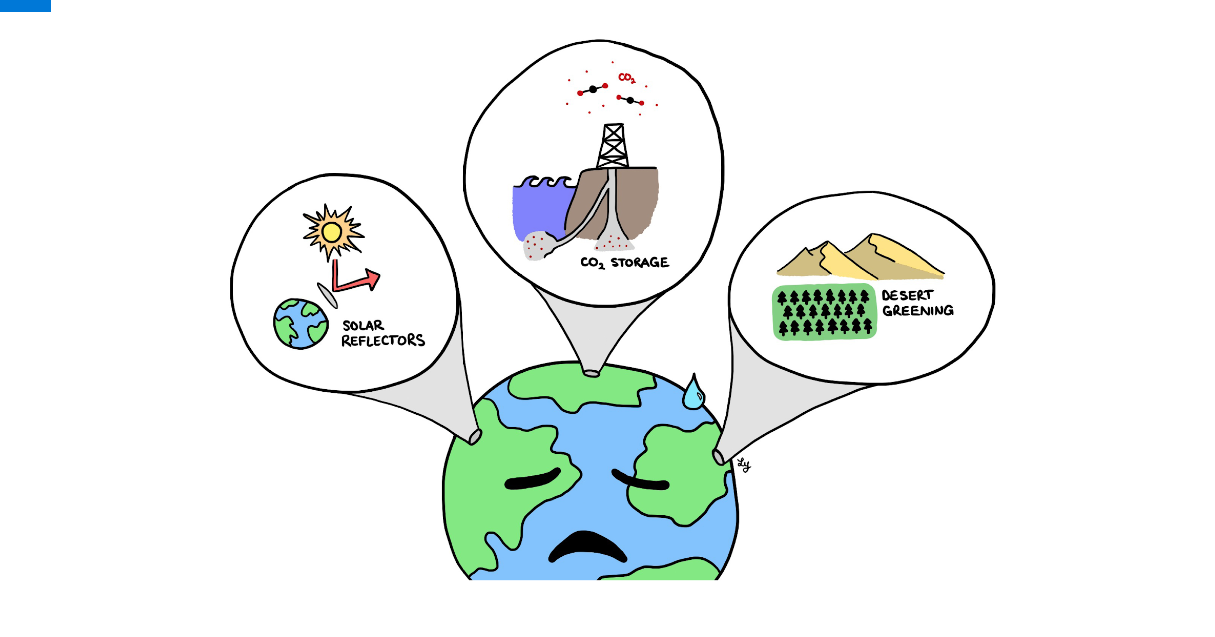The conversation around geoengineering, otherwise known as climate intervention or climate engineering, is gaining traction as climate projections remain dire. Offering many salient yet controversial ways to mitigate Earth’s rising temperatures, geoengineering methods include spraying sulphate particulates into the atmosphere to block out solar radiation, fertilizing the ocean with iron to capture more carbon, and injecting atmospheric carbon dioxide into rock deep beneath the Earth’s surface.
The Intergovernmental Panel on Climate Change (IPCC) has increasingly warned that countries must reduce emissions to avoid a two degrees Celsius jump in temperature, which would result in widespread social inequality and environmental degradation. Despite these warnings, emissions continue to rise, pushing scientists like Nigel Roulet, the Chair of the Department of Geography at McGill, to consider emissions-curbing experimental methods.
“There are two areas of geoengineering, and the distinction is important,” Roulet said in an interview with The McGill Tribune. “Soft geoengineering [includes methods] that we can do that could enhance processes that are already going on to remove carbon dioxide from the atmosphere, such as increasing forest growth or having white roofs. Hard geoengineering [includes] methods that involve trying to intervene in the climate system.”
Most techniques that people associate with geoengineering fall into the hard geoengineering category, a form that Roulet considered quite dangerous for two reasons.
“[First of all], we are not equipped with such an advanced understanding of the climate systems to forecast the possible consequences and externalities of hard geoengineering techniques,” Roulet said. “The second [worry] is the possible geopolitical consequences [….] If one state had access to geoengineering technology […], what would that mean for the global system and global effects?”
Geoengineering is often not discussed in a way that differentiates between pure climate intervention and techniques that simply enhance processes that are already occurring. Roulet believes that geoengineering merits closer examination and cannot be accepted as a quick fix to the climate crisis.
However, it is possible that as soon as geoengineering takes off, it could drain attention from examining human overconsumption.
“We have massive problems in our society that are associated with overconsumption,” Roulet said. “Thinking that technology is going to fix our problems is delusional. We need to reduce our consumption [by] a tremendous amount and ask ourselves questions like ‘How many people can the planet support with reasonable wellbeing?”
According to Roulet, geoengineering cannot possibly address the fundamental problems of climate change, such as social inequality, exploitation of people and resources, and overconsumption. Geoengineering simply masks the symptoms. Roulet compared the danger of relying on geoengineering to taking a Tylenol when you have a cold. The difference is that Tylenol does not generally result in significant negative side effects, whereas geoengineering could have harmful consequences like altering the oxygen levels in oceans, decreasing biodiversity, and changing rainfall patterns. Scientists simply do not know enough—and might never know enough—about large-scale atmospheric processes to predict what sequestering carbon dioxide or trying to reduce the amount of sunlight reaching the Earth would do at the global scale.
“Some methods of geoengineering are like jumping out of a frying pan into the fire, such as spraying sulphate particulars in the air,” Roulet said.
Technology will be part of the climate solution, but it cannot be the only fix. Geoengineering targets large sources of carbon dioxide like transportation and animal agriculture but does not address the smaller ones that humans emit every day.
“Humans are not well enough evolved to handle overwhelming questions,” Roulet said. “If there are readily available geoengineering solutions, we will not be forced to sit down and look at ourselves.”
Geoengineering suggestions are as diverse as they are fanciful. If humans have such a big imagination when it comes to technology, then the same could be possible for our ability to conceive different ways of implementing social and institutional changes.









– It may be a band aid, but band aids do a great job until other healing takes over (electric cars and aircraft, huge solar arrays in the sea and desert, synthetic meat and dairy, etc.)
– Believe me, I have preached about carbon reduction for twenty years, to no avail. The public is simply not willing to make the sacrifices of car use, industrial production, home heating, air trips , home heating, and consumerism.
– So the ‘realistic’ solution seems to me to be urgent shielding of the planet from sun fall. Currently the world pays $605 billion a year for damage caused by climate change. See links to references and authorities at bit.ly/2Ls2I0B The cost of putting particles into the stratosphere would be around $10B a year. It’s ‘scalable’ which means it can be done cautiously small, stepped up, stepped down as we like. And it isn’t permanent – a few years and it falls out again. Obviously there are some harms from it. But they are miniscule compared with the current 45 billion tonnes of emissions of decades-persistent carbon that is causing the wind storms, sea level rise, droughts, fires floods, migrations, species loss.